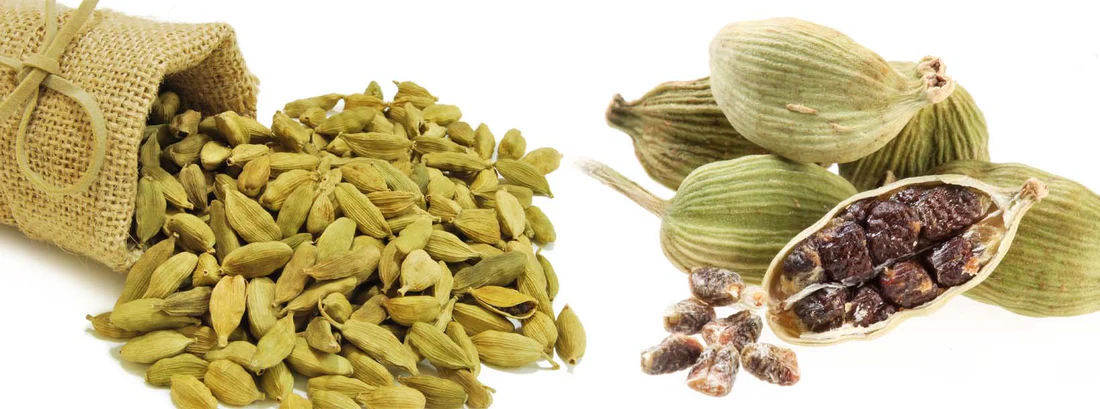
Ceylon Cardamom
Popularly known as ‘Queen of spices’ as opposed to Black Pepper hailed as ‘King of Spice’, Cardamom, sometimes spelt as cardamon or cardamum, is a spice made from the seeds of several plants in the genera Elettaria and Amomum in the family Zingiberaceae. Both genera are native to the Indian subcontinent and Indonesia. The cardamom plant is a perennial herbaceous plant with a pseudostem and thick irregular shaped rhizomes. Dried fruit or cardamom pod is traded as a spice.
Cardamom pods are spindle-shaped and have a triangular cross-section. The pods contain a number of seeds, which are small and black, while the pods differ in colour and size by spices. Cardamom is generally available in the form of whole fruit as a primary product, in-ground form as secondary processed products and also in the form of extractions of oil and oleoresin as value-added products. Cardamom lands are generally termed as spice forests. Sri Lankan Cardamom suppliers export light green cardamom variety (Elettaria cardamomom), which is one of the most expensive spices by weight.
Due to the unique flavour of green cardamom cultivated in Sri Lanka, formed by the country’s unique terroir, green cardamom produced in Sri Lanka is known as Ceylon Cardamom.
Ceylon Cardamom is available in various forms in the global market;
- The whole Cardamom is the whole pod, with seeds intact.
- Ground cardamom is the cardamom powder. Cardamom is usually known for having a reduction of flavour once the seeds are ground but is used in culinary recipes.
- Cardamom oil is the essential oil derived from cardamom pods through steam distillation. Known for its uplifting and energizing fragrance, Cardamom oil has a therapeutic and aromatic blend. The clear and thin oil is ideal to blend with other oils and has a spicy, woody, and sweet aroma.
The country serves about 0.1% of the global demand for cardamom which amounts to 4000 to 5000t per annum. India, Australia, Canada and Estonia are the main buyers of Ceylon Cardamom, which is available in two grades; namely LG Lanka Green Cardamom (LG) and Lanka Light Green Cardamom (LLG).
In Sri Lanka, cardamom is mainly cultivated in the districts of Kandy, Matale, Kegalle, Nuwara Eliya, Ratnapura and a part of Galle. Three types of Cardamom are found in Sri Lanka and they’re categorized based on the shape of the inflorescence.
- Malabar – Inflorescence is prostrate.
- Mysore – Inflorescence is vertical.
- Vazhukka- Inflorescence is inclined.
Consumption of cardamom has drastically gone up throughout the world during the last two decades. Cardamom is mainly consumed in the Middle Eastern countries, India, Pakistan, European countries, the USA, and Japan. In fact, Middle Eastern countries such as Saudi Arabia and the United Arab Emirates, and South-East Asian countries such as India, account for over 60% of the global consumption.
COOKING WITH CARDAMOM
Cardamom has a complex flavour profile - it's citrusy, minty, spicy, and herbal all at the same time while being highly fragrant too. Cardamom is mainly used in the food industry as a flavouring agent. Cardamom Oil is used for flavouring of beverages and drinks such as coffee and tea while cardamom pods and ground cardamom is used to spice up both sweet and savoury dishes. It is widely used in Indian, Middle Eastern, Arabic, and Swedish cuisine. Cardamom is found in the garam masala spice mixture that seasons meat and vegetable dishes, and in hot beverages such as masala chai and Turkish coffee.
CARDAMOM MEDICINAL USES
Cardamom possesses a number of health benefits; namely, antiseptic (pulmonary), antispasmodic (neuromuscular), aphrodisiac, expectorant, anthelmintic, antibacterial (variable), cephalic, cardiotonic, diuretic, emmenagogue, sialogogue and stomachic. It’s also anti-inflammatory and is reportedly an antidote for both snake and scorpion venom. It’s also hepatoprotective and anti-ulcerogenic.
Cardamom’s many health benefits include ;
- Reduces blood pressure
- Protects from chronic diseases
- Reduces the occurrence of ulcers and other digestive problems
- Improves oral health
- Reduce blood sugar
- In addition, cardamom’s anti-inflammatory and antioxidant properties are believed to reduce the occurrence of
- cancer and improve general health
HISTORY OF CARDAMOM AS A SPICE
Cardamom is reported to be one of the oldest spices known to the world. Cardamom originally came from wild plants in the Western Ghats in Southern India. The plants so proliferated in this region that this area came to be called Cardamom Hills.
The use of this spice dates back at least four millennia. Ancient Egyptians used Cardamom for many medicinal purposes, as part of rituals and even for embalming. They chewed cardamom pods as a way to help keep their breath minty and to help clean their teeth. The Greeks and Romans used Cardamom for its pungent aroma. It was a key ingredient in perfume and aromatic oils.
Vikings first discovered this spice during their travels and brought it back to Scandinavia. During the 19th century, plantations of cardamom were set up by British colonists and this is where much of the green and black cardamom even today.
